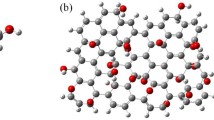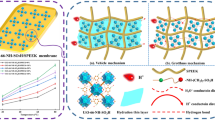Abstract
A novel composite material based on poly(acrylate) (PAA) and graphene oxide (GO) has been developed to serve as a proton exchange membrane (PEM). This new material shows great promise in enhancing the mobility of hydronium (H3O) ions, particularly under challenging operating conditions. To explore its potential, comprehensive studies were carried out using classical all-atom molecular dynamics (MD) simulations with the Gromacs software to understand the formation mechanism and investigate its application for H3O ion transportation in PEM. During the MD simulations, it was observed that an increase in hydration from 3 to 9 in the PAA oligomer and GO-based PEM resulted in the formation of larger water clusters. These clusters facilitated more efficient transportation of H3O ions. The study also revealed the development of new interactions between PAA oligomers and GO layers at specific hydration levels (HLs) (3/9) and temperatures (298 K/350 K), as evidenced by the analysis of interaction energies. Furthermore, the mobility of H3O ions in the PAA and GO composite–based PEM exhibited behavior comparable to that of the traditional PAA-based PEM at various HLs and temperatures. Additionally, the transportation of H3O ions showed a slight increase with higher HL and temperature, as indicated by the diffusion coefficient values for the GO and PAA composite–based PEM. In summary, the newly developed PAA and GO composite material holds promise for improving the mobility of H3O ions, making it an excellent candidate for PEM applications. The insights gained from the MD simulations shed light on the material’s formation mechanism and behavior under different conditions, providing a solid foundation for further research and potential real-world applications in the field of membrane technologies.








Similar content being viewed by others
Data availability
The datasets generated during and/or analyzed during the current study are available from the corresponding author on reasonable request.
Abbreviations
- PEM:
-
Proton exchange membrane
- GO:
-
Graphene oxide
- PAA:
-
Poly(acrylate)
- MD:
-
Molecular dynamics
- MSD:
-
Mean square displacement
- H3O:
-
Hydronium ion
- HL:
-
Hydration level
References
Jayakumar A, Sethu SP, Ramos M, Robertson J, Al-Jumaily A (2015) A technical review on gas diffusion, mechanism and medium of PEM fuel cell. Ionics 21:1–18
Amouei Torkmahalleh M, Karibayev M, Konakbayeva D, Fyrillas MM, Rule AM (2018) Aqueous chemistry of airborne hexavalent chromium during sampling. Air Qual Atmos Health 11:1059–1068
Kan WH, Thangadurai V (2015) Challenges and prospects of anodes for solid oxide fuel cells (SOFCs). Ionics 21:301–318
Hermann A, Chaudhuri T, Spagnol P (2005) Bipolar plates for PEM fuel cells: a review. Int J Hydrogen Energy 30(12):1297–1302
Yue M, Lambert H, Pahon E, Roche R, Jemei S, Hissel D (2021) Hydrogen energy systems: a critical review of technologies, applications, trends and challenges. Renew Sustain Energy Rev 146:111180
Zarandi RF, Rezaei B, Ghaziaskar HS, Ensafi AA (2020) Modification of copper electrode with copper nanoparticles@ reduced graphene oxide–Nile blue and its application in electrochemical CO2 conversion. Mater Today Energy 18:100507
Munjewar SS, Thombre SB, Mallick RK (2017) A comprehensive review on recent material development of passive direct methanol fuel cell. Ionics 23:1–18
Saadat N, Dhakal HN, Tjong J, Jaffer S, Yang W, Sain M (2021) Recent advances and future perspectives of carbon materials for fuel cell. Renew Sustain Energy Rev 138:110535
Das I, Das S, Dixit R, Ghangrekar MM (2020) Goethite supplemented natural clay ceramic as an alternative proton exchange membrane and its application in microbial fuel cell. Ionics 26:3061–3072
Karthikeyan S, Selvasekarapandian S, Premalatha M, Monisha S, Boopathi G, Aristatil G et al (2017) Proton-conducting I-carrageenan-based biopolymer electrolyte for fuel cell application. Ionics 23:2775–2780
Khandaker S, Das S, Hossain MT, Islam A, Miah MR, Awual MR (2021) Sustainable approach for wastewater treatment using microbial fuel cells and green energy generation–a comprehensive review. J Mol Liq 344:117795
Roziere J, Jones DJ (2003) Non-fluorinated polymer materials for proton exchange membrane fuel cells. Annu Rev Mat Res 33(1):503–555
Bose S, Kuila T, Nguyen TXH, Kim NH, Lau KT, Lee JH (2011) Polymer membranes for high temperature proton exchange membrane fuel cell: recent advances and challenges. Prog Polym Sci 36(6):813–843
Gao J, Dong X, Tian Q, He Y (2023) Carbon nanotubes reinforced proton exchange membranes in fuel cells: an overview. Int J Hydrogen Energy 48(8):3216–3231
Dekel, DR (2018) Review of cell performance in anion exchange membrane fuel cells. J Power Sources 375:158–169
Sankir M, Kim YS, Pivovar BS, McGrath JE (2007) Proton exchange membrane for DMFC and H2/air fuel cells: synthesis and characterization of partially fluorinated disulfonated poly (arylene ether benzonitrile) copolymers. J Membr Sci 299(1-2):8–18
Hamrock SJ, Yandrasits MA (2006) Proton exchange membranes for fuel cell applications. J Macromol Sci Polym Rev 46(3):219–244
Song HB, Park JH, Park JS, Kang MS (2021) Pore-filled proton-exchange membranes with fluorinated moiety for fuel cell application. Energies 14(15):4433
Shabani M, Younesi H, Pontié M, Rahimpour A, Rahimnejad M, Zinatizadeh AA (2020) A critical review on recent proton exchange membranes applied in microbial fuel cells for renewable energy recovery. J Clean Prod 264:121446
Xiao T, Wang R, Chang Z, Fang Z, Zhu Z, Xu C (2020) Electrolyte membranes for intermediate temperature proton exchange membrane fuel cell. Prog Nat Sci: Mater Int 30(6):743–750
Xu M, Xue H, Wang Q, Jia L (2021) Sulfonated poly (arylene ether) s based proton exchange membranes for fuel cells. Int J Hydrogen Energy 46(62):31727–31753
Mokrini A, Huneault MA, Shi Z, Xie Z, Holdcroft S (2008) Non-fluorinated proton-exchange membranes based on melt extruded SEBS/HDPE blends. J Membr Sci 325(2):749–757
Ogungbemi E, Ijaodola O, Khatib FN, Wilberforce T, El Hassan Z, Thompson J et al (2019) Fuel cell membranes–pros and cons. Energy 172:155–172
Sedesheva YS, Ivanov VS, Wozniak AI, Yegorov AS (2016) Proton-exchange membranes based on sulfonated polymers. Orient J Chem 32(5):2283
Zhakiyev N, Tynyshtykbayev K, Norem J, Insepov Z (2019) Highly effective anti-corona coatings on aluminium wires by surface modification. J Phys D Appl Phys 53(1):015503
Karatasos K, Kritikos G (2016) Characterization of a graphene oxide/poly (acrylic acid) nanocomposite by means of molecular dynamics simulations. RSC Adv 6(111):109267–109277
Varcoe JR, Robert CTS (2005) Prospects for alkaline anion‐exchange membranes in low temperature fuel cells. Fuel cells 5(2):187–200
Gokhale AA, Lu J, Parker NJ, Izbicki AP, Sanyal O, Lee I (2013) Conductive oxygen barrier films using supramolecular assembly of graphene embedded polyelectrolyte multilayers. J Colloid Interface Sci 409:219–226
Chen, J. T., Fu, Y. J., An, Q. F., Lo, S. C., Huang, S. H., Hung, W. S., et. al. (2013). Tuning nanostructure of graphene oxide/polyelectrolyte LbL assemblies by controlling pH of GO suspension to fabricate transparent and super gas barrier films. Nanoscale 5(19): 9081-9088
Hazell G, Hinojosa-Navarro M, McCoy TM, Tabor RF, Eastoe J (2016) Responsive materials based on magnetic polyelectrolytes and graphene oxide for water clean-up. J Colloid Interface Sci 464:285–290
Liang L, Fan J, Wang M, Chen G, Sun G (2020) Ternary thermoelectric composites of polypyrrole/PEDOT: PSS/carbon nanotube with unique layered structure prepared by one-dimensional polymer nanostructure as template. Compos Sci Technol 187:107948
Zhao Z, Richardson GF, Meng Q, Zhu S, Kuan HC, Ma J (2015) PEDOT-based composites as electrode materials for supercapacitors. Nanotechnology 27(4):042001
Hasani-Sadrabadi MM, Mokarram N, Azami M, Dashtimoghadam E, Majedi FS, Jacob KI (2011) Preparation and characterization of nanocomposite polyelectrolyte membranes based on Nafion® ionomer and nanocrystalline hydroxyapatite. Polymer 52(5):1286–1296
Zhang J, Hreid T, Li X, Guo W, Wang L, Shi X et al (2010) Nanostructured polyaniline counter electrode for dye-sensitised solar cells: Fabrication and investigation of its electrochemical formation mechanism. Electrochim Acta 55(11):3664–3668
Shah D, Karibayev M, Adotey EK, Amouei Torkmahalleh M (2020) Impact of volatile organic compounds on chromium containing atmospheric particulate: insights from molecular dynamics simulations. Sci Rep 10(1):17387
Shi X, Wang Y, Sun H, Chen Y, Zhang X, Xu J, Zhai G (2019) Heparin-reduced graphene oxide nanocomposites for curcumin delivery: in vitro, in vivo and molecular dynamics simulation study. Biomater Sci 7(3):1011–1027
Tai Z, Yang J, Qi Y, Yan X, Xue Q (2013) Synthesis of a graphene oxide–polyacrylic acid nanocomposite hydrogel and its swelling and electroresponsive properties. RSC Adv 3(31):12751–12757
Berendsen HJC (1991) Transport properties computed by linear response through weak coupling to a bath. In: Computer simulation in materials science: interatomic potentials, simulation techniques and applications. Springer Netherlands, Dordrecht, pp 139–155
Van Der Spoel D, Lindahl E, Hess B, Groenhof G, Mark AE, Berendsen HJ (2005) GROMACS: fast, flexible, and free. J Comput Chem 26(16):1701–1718
Humphrey W, Dalke A, Schulten K (1996) VMD: visual molecular dynamics. J Mol Graph 14(1):33–38
Chen L, He YL, Tao WQ (2014) The temperature effect on the diffusion processes of water and proton in the proton exchange membrane using molecular dynamics simulation. Numer Heat Transf; A: Appl 65(3):216–228
Arntsen C, Savage J, Tse YL, Voth GA (2016) Simulation of proton transport in proton exchange membranes with reactive molecular dynamics. Fuel Cells 16(6):695–703
Mabuchi T, Tokumasu T (2019) Effects of water nanochannel diameter on proton transport in proton-exchange membranes. J Polym Sci B 57(13):867–878
Acknowledgements
The authors acknowledge the support of International Science Complex Astana for providing us with computational resources.
Authors contribution
Kazybek Aimaganbetov: Methodology, Formal Analysis, Writing – original draft
Kanat Ospanov: Conceptualization, Formal Analysis, Writing – review & editing
Nurlan Almassov: Conceptualization, Formal Analysis, Supervision, Writing – review & editing.
Funding
This work was supported by the Committee of Science of the Ministry of Education and Science of the Republic of Kazakhstan via Grant № AP14871389 “Development of the scientific basis of the nanomembrane fabrication technology for proton separation in a fuel cell.”
Author information
Authors and Affiliations
Corresponding author
Ethics declarations
Ethical approval
Not applicable.
Competing interests
The authors have no relevant financial or non-financial interests to disclose.
Additional information
Publisher’s Note
Springer Nature remains neutral with regard to jurisdictional claims in published maps and institutional affiliations.
Supplementary information
ESM 1
(RAR 15 kb)
Rights and permissions
Springer Nature or its licensor (e.g. a society or other partner) holds exclusive rights to this article under a publishing agreement with the author(s) or other rightsholder(s); author self-archiving of the accepted manuscript version of this article is solely governed by the terms of such publishing agreement and applicable law.
About this article
Cite this article
Aimaganbetov, K., Ospanov, K. & Almas, N. Mobility of hydronium ion for graphene oxide– and poly(acrylate)-based proton exchange membranes at the molecular level. Ionics 29, 5405–5415 (2023). https://doi.org/10.1007/s11581-023-05245-y
Received:
Revised:
Accepted:
Published:
Issue Date:
DOI: https://doi.org/10.1007/s11581-023-05245-y




